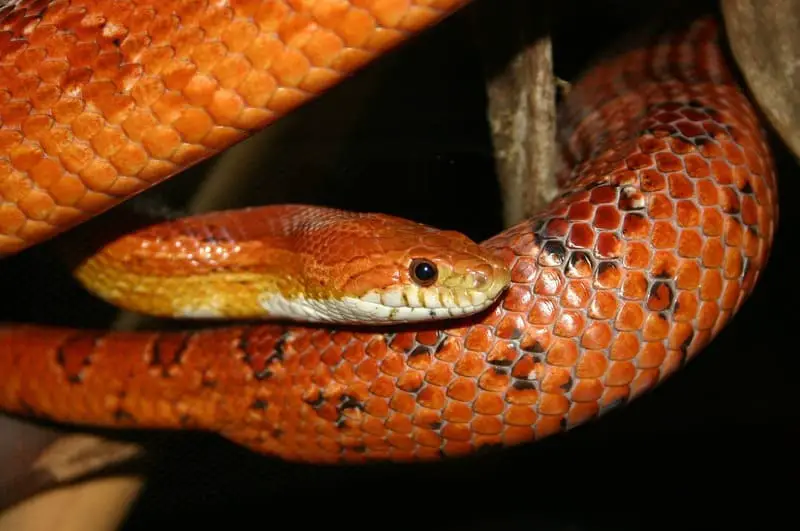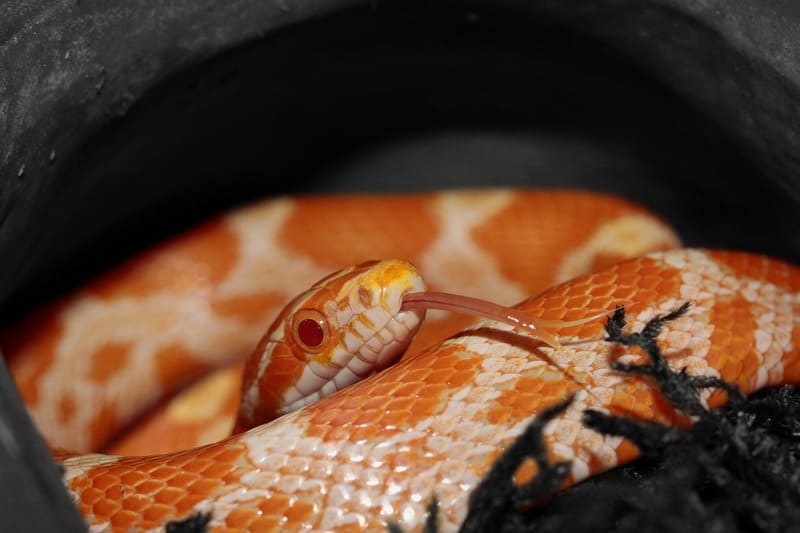Shedding is a natural and vital process for all snakes, including corn snakes (Pantherophis guttatus). Shedding, also known as molting or ecdysis, is the process by which snakes replace their old, worn-out skin with a new layer. Shedding not only helps snakes maintain their appearance but also serves various essential functions, including growth and the removal of parasites. In this comprehensive guide, we will explore the shedding process in corn snakes, discussing how often they shed, the signs of an impending shed, the stages of the shedding process, and how to assist your pet corn snake during the shedding process.

Understanding Corn Snakes
Before diving into the specifics of shedding in corn snakes, it’s important to have a basic understanding of this popular snake species.
Taxonomy:
- Kingdom: Animalia (Animals)
- Phylum: Chordata (Chordates)
- Class: Reptilia (Reptiles)
- Order: Squamata (Scaled Reptiles)
- Family: Colubridae (Colubrid Snakes)
- Genus: Pantherophis
- Species: Pantherophis guttatus
Common Names: Corn Snake, Red Rat Snake
Corn snakes are native to North America and are widely recognized for their attractive appearance, characterized by vibrant colors and distinctive patterns. They are non-venomous and are considered one of the most docile and easy-to-care-for snake species, making them a popular choice among reptile enthusiasts and first-time snake owners.
Shedding in Corn Snakes: An Overview
Shedding is a completely natural and recurring process in a corn snake’s life. This process allows them to grow, maintain their skin’s health, and rid themselves of any potential parasites that may be clinging to their old skin. The frequency of shedding varies based on the age and growth rate of the snake.
How Often Do Corn Snakes Shed?
The frequency of shedding in corn snakes is influenced by several factors, including age, growth rate, and individual health. In general, younger corn snakes shed more frequently than adults. Here is a breakdown of shedding frequency for different age groups:
- Hatchlings and Juveniles: When corn snakes are young, they grow rapidly, and as a result, they shed more frequently. Hatchlings may shed their skin every 7-10 days in their early stages. As they mature into juveniles, the shedding frequency decreases to approximately once every 2-4 weeks.
- Sub-Adults and Adults: As corn snakes reach sub-adulthood and adulthood, their growth rate slows down. Sub-adults may shed every 4-8 weeks, while adult corn snakes typically shed every 6-12 weeks.
It’s important to note that these are general guidelines, and individual corn snakes may vary in their shedding schedules. Some factors that can influence the shedding frequency include diet, temperature, humidity, and overall health.
Signs of an Impending Shed
Corn snakes exhibit several behavioral and physical signs to indicate that they are about to shed. Recognizing these signs is important for snake owners to ensure their pets go through the shedding process without any issues. Common signs of an impending shed include:
- Blue Cloudy Eyes: A few days before shedding, a corn snake’s eyes become cloudy and bluish. This is a result of a fluid buildup between the old and new layers of skin. The cloudy eyes may affect the snake’s vision temporarily.
- Dull Skin: As the shedding process approaches, the snake’s skin may appear dull and lackluster. This is because the old skin is about to be replaced by the new one.
- Reduced Activity: Corn snakes tend to be less active in the days leading up to shedding. They may hide more and exhibit a decrease in appetite.
- Pink Belly Scales: In the final stages of the shedding process, the snake’s belly scales may become pink or reddish. This is an indicator that the snake is ready to shed.
Stages of the Shedding Process
The shedding process in corn snakes occurs in several distinct stages. Understanding these stages will help you monitor and assist your pet snake during the process:
- Pre-Shedding: This is the initial stage when the snake’s body starts preparing for the upcoming shed. The eyes become cloudy, and the snake may become less active.
- Shedding: During this stage, the snake actively works to remove the old skin. It typically starts by rubbing its nose against rough surfaces, such as rocks or branches, to loosen the skin around its mouth. Then, it progresses to slithering through tight spaces to help remove the rest of the old skin.
- Post-Shedding: After successfully shedding its old skin, the snake’s new skin is revealed. At this stage, the snake may appear vibrant and rejuvenated. However, it is essential to ensure that the shed is complete and that no patches of old skin remain, especially on the eyes.
Assisting a Corn Snake During Shedding
While corn snakes are generally proficient at shedding on their own, there are instances where they may require assistance. If you notice that your snake is having difficulty shedding, there are several steps you can take to help:
- Increased Humidity: Maintaining appropriate humidity levels in the snake’s enclosure is crucial. A humidity level of 50-60% is recommended for corn snakes, but it should be increased to 70-80% during shedding to facilitate the process.
- Provide a Shed Box: Creating a shed box within the enclosure can help the snake by providing a humid microenvironment. The shed box should contain dampened sphagnum moss or paper towels.
- Minimize Handling: During the shedding process, it’s best to minimize handling your corn snake. Handling can cause stress and hinder the shedding process.
- Check for Retained Shed: After the snake has shed, inspect it carefully to ensure there are no retained shed pieces, especially on the eyes. If retained shed is present, it can cause health issues and should be gently removed.
- Monitor Overall Health: Ensure that the snake’s overall health is optimal. A well-balanced diet, proper temperatures, and adequate hydration are essential to a smooth shedding process.
Retained Eye Caps
One common issue during shedding is retained eye caps, where the old skin over the snake’s eyes fails to come off completely. This can obstruct the snake’s vision and lead to health problems if left unaddressed. If you notice retained eye caps, it’s important to take action:
- Consult a Veterinarian: If you are uncomfortable removing retained eye caps yourself, or if the situation is severe, it’s best to seek professional help from a veterinarian experienced in reptile care.
- Home Remedies: In some cases, you may be able to remove retained eye caps at home. A common method is to use a moistened cotton swab to gently rub over the eye cap. Be extremely gentle to avoid injuring the snake.
Special Considerations
It’s worth noting that not all snakes will shed perfectly every time. Some may have issues with retained shed or other complications. If you encounter ongoing shedding problems with your corn snake, it’s advisable to consult a reptile veterinarian for guidance and potential medical intervention.

Conclusion
Shedding is a vital and natural process for corn snakes, allowing them to grow, maintain their health, and get rid of potential parasites. The frequency of shedding varies based on age and growth rate. Young snakes shed more frequently than adults. Recognizing the signs of an impending shed is important for snake owners, as is understanding the stages of the shedding process.
Assisting a corn snake during shedding may be necessary if the snake encounters difficulties, such as retained eye caps. Maintaining proper humidity levels in the enclosure, providing a shed box, and minimizing handling during the process can all contribute to a successful shed.
Ultimately, shedding is a fascinating and necessary aspect of a corn snake’s life, and understanding it is essential for providing proper care and ensuring the health and well-being of these captivating reptiles.
